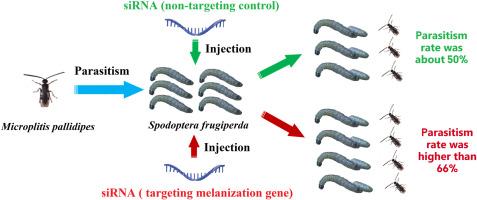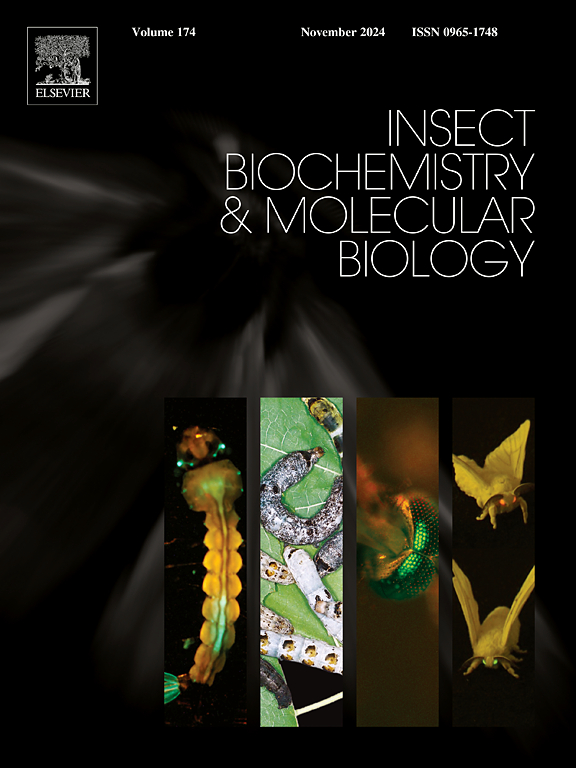夜蛾对类内寄生虫苍白微囊炎的黑化免疫反应
IF 3.7
2区 农林科学
Q2 BIOCHEMISTRY & MOLECULAR BIOLOGY
引用次数: 0
摘要
夜蛾(鳞翅目:夜蛾科)是一种世界性入侵害虫。斑胸小蜂(膜翅目:小蜂科)是该害虫的一种内寄生昆虫。然而,这种害虫对白僵菌的黑化免疫反应尚未被探索。结果表明,白僵菌寄生于果蚜后,严重抑制了果蚜幼虫血淋巴黑色素化和酚氧化酶活性。转录组学和蛋白质组学分析表明,1128个基因和594个蛋白在寄生后表达显著改变。其中包括23个参与frugiperda黑色素化的候选基因中的12个(即7个识别蛋白基因、10个酚氧化酶原级联基因和6个黑色素合成基因)。在sirna处理后24 h或48 h,这12个黑化基因中的8个在frugiperda幼虫中显著下调。其中,RNAi敲低PPO1、PPO2和TH(酪氨酸羟化酶)可使寄生率提高13.3% ~ 23.3%,使淋巴黑化率降低36.7% ~ 66.7%。我们的研究结果提供了对S. frugiperda黑化反应的深入了解,并确定了在这一过程中发挥关键作用的基因。这些发现揭示了食草昆虫对寄生的反应机制,并对寄生蜂对害虫的生物防治具有应用意义。本文章由计算机程序翻译,如有差异,请以英文原文为准。

Melanization immune response of Spodoptera frugiperda to an endoparasitoid Microplitis pallidipes
Spodoptera frugiperda Smith (Lepidoptera: Noctuidae) is a worldwide invasive pest. Microplitis pallidipes Szépligeti (Hymenoptera: Braconidae) is an endoparasitoid of this pest. However, the melanization immune response of this pest to M. pallidipes, has not yet been explored. We found that the parasitism of S. frugiperda by M. pallidipes severely inhibited hemolymph melanization and phenoloxidase activity of larvae. Transcriptomic and proteomic analysis indicated that 1128 genes and 594 proteins were significantly altered in expression following parasitism. These included 12 of the 23 candidate genes involved in melanization in S. frugiperda (i.e., 7 recognition protein genes, 10 prophenoloxidase (PPO) cascade genes, and 6 melanin synthesis genes). Eight of these 12 melanization genes were significantly downregulated in S. frugiperda larvae 24 h or 48 h after treatment with siRNAs. Of these, RNAi knockdown of PPO1, PPO2 and TH (tyrosine hydroxylase) increased parasitism rate by 13.3 %–23.3 % and decreased hemymphatic melanization rate by 36.7–66.7 %. Our results provide insight into the melanization response of S. frugiperda and identify genes that appear to play a key role in this process. These findings shed light on the mechanisms by which insect herbivores respond to parasitism, and have applied implications for the biological control of insect pests by parasitic wasps.
求助全文
通过发布文献求助,成功后即可免费获取论文全文。
去求助
来源期刊
CiteScore
7.40
自引率
5.30%
发文量
105
审稿时长
40 days
期刊介绍:
This international journal publishes original contributions and mini-reviews in the fields of insect biochemistry and insect molecular biology. Main areas of interest are neurochemistry, hormone and pheromone biochemistry, enzymes and metabolism, hormone action and gene regulation, gene characterization and structure, pharmacology, immunology and cell and tissue culture. Papers on the biochemistry and molecular biology of other groups of arthropods are published if of general interest to the readership. Technique papers will be considered for publication if they significantly advance the field of insect biochemistry and molecular biology in the opinion of the Editors and Editorial Board.

 求助内容:
求助内容: 应助结果提醒方式:
应助结果提醒方式:


